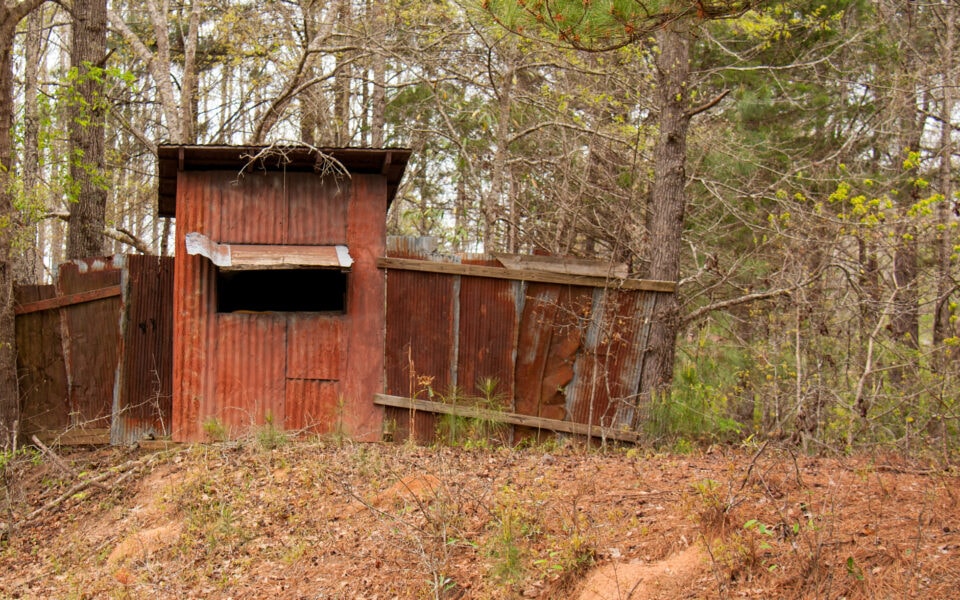Hunting blinds, there not always fancy. In fact, many would call it mundane. It is six feet wide, four feet deep, and eight feet tall. The materials used to build it were salvaged from an old tenant house built on the farm in the early 1900s. It sits on the end of a spoil bank leftover from the creation of a run-off pond and spillway. It faces east and overlooks a small, one-acre food plot.
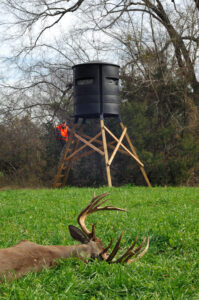 In the south, some call it a “shooting house.” Others may call it a “blind,” “box blind” or “permanent stand.” I call it “My Happy Place.” It is not in an isolated area or far off the beaten path. In fact, it is less than 300 yards from the front door of my house. Thinned, managed 22-year old pines border the food plot on the south and north sides. To the east is a large bedding area consisting of native grasses, weeds, briars, scattered pines, and hardwood drains.
In the south, some call it a “shooting house.” Others may call it a “blind,” “box blind” or “permanent stand.” I call it “My Happy Place.” It is not in an isolated area or far off the beaten path. In fact, it is less than 300 yards from the front door of my house. Thinned, managed 22-year old pines border the food plot on the south and north sides. To the east is a large bedding area consisting of native grasses, weeds, briars, scattered pines, and hardwood drains.
A west wind is taboo. Any other wind will do, but I prefer northeast. I can get in and out with no chance of being seen. The spoil bank and spillway cover my approach until I climb onto the spoil bank to enter the stand. A wing built out of old tin and attached on either side provides cover for the last 20 yards of approach.
Once inside, again, nothing fancy. Two old office chairs afford a comfortable place to sit. The floor and walls are covered with carpet and the tin roof keeps everything dry. There are compartments built along the walls that hold bottled water and an “NBC” (nothing but candy) container.
This is where I took the biggest buck ever killed on the farm. He was a five-year-old, 21” inside spread, 235-pound nine-point. This where I have shot other mature bucks and where I am comfortable spending my time. Like I said, this is my “happy place.”
This shooting house has been in the same place since my father-in-law put it there over thirty years ago. It was his happy place then. It was a good place then but is a better place now. Intense Gamekeeper management of the pine plantations, food plots, and deer herd has improved my odds of shooting a mature buck from this stand.
Establish A Hunting Blind Location
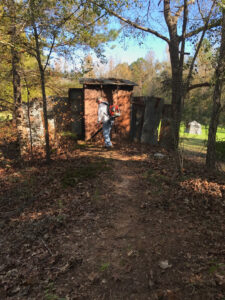
The location you choose for your shooting house should obviously provide ample food and cover for deer, but there are more factors than just food and cover that cause deer to use a specific area frequently. In order to justify the effort, expense and increase your odds for success, look for specific reasons for deer to visit an area. The more reasons for deer to be in a certain area, the better the site is suited for a “permanent stand.” Here are a few areas high on my list when searching for a place to put a permanent stand:
Pinch Points
A pinch point can be where a wood lot narrows due to fields on either side or where a creek forms a narrow passage between the creek and woods edge – wherever you can restrict their movement to a smaller zone. Pinch points are good locations for permanent stands because deer are naturally funneled through the narrow area between two or more obstacles. When putting a permanent stand at a pinch point, pay close attention to prevailing wind directions. I like to place the stand where I can hunt it with as many wind directions as possible. I also keep in mind where the wind will come from on colder days since deer tend to move more in cold weather.
Crossings
Deer tend to cross creeks, gullies, roads, fences, or water in the same place time after time. These crossings are usually located at the easiest place for the deer to cross the obstacle. A shallow or narrow place in a slough, a place where a creek bank is not as steep or where a gully is not as sharp, are good locations for crossings.
Feeding Areas
Feeding areas can be food plots, browsing areas, or areas where the mast is available at certain times of the year. Food plots are perhaps the best feeding area for a shooting house due to the fact that they offer deer food for prolonged periods of time where mast crops are seasonal. An area that offers both, planted and natural food sources is an excellent spot for a permanent stand.
Trails
Trails are a good location for permanent stands, especially where multiple trails converge and can be covered from the stand. Deer prefer certain travel routes. Repeated use of these routes obviously forms a trail. The more trails you can cover from a permanent stand the better your chances for success.
Escape Routes
Escape routes are used by deer when they feel pressure and decide to vacate the area. These routes are often hard to locate but can be very productive when other hunters are in the area. Deer tend to use these routes over and over again. If it keeps them safe once, chances are they’ll use it again if the conditions are similar. Look for faint trails leading into thickets or dense cover. Also, look for undisturbed areas near roads or steep terrain.
Back in the day, sign on the ground such as tracks, droppings, rubs, scrapes, or visual observations were key methods of determining where to locate a permanent stand. Today, however, trail cameras are invaluable in determining stand sites. Properly placed and programmed trail cameras eliminate the guesswork and document the “who, when, and where” of deer activity in a given area. Trail cameras that offer time-lapse mode are particularly effective for determining deer movement in a given area.
Make Your Blind More Productive
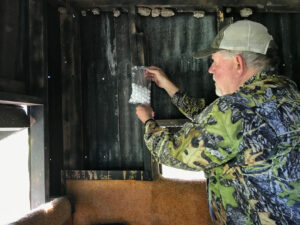 When building or purchasing a shooting house, consider the size blind you want. It should be large enough to be comfortable and house accessories such as snacks, water, portable heater, comfortable chairs, and you. You may want to make it large enough for a companion to share. After all, you will spend a lot of time at this location.
When building or purchasing a shooting house, consider the size blind you want. It should be large enough to be comfortable and house accessories such as snacks, water, portable heater, comfortable chairs, and you. You may want to make it large enough for a companion to share. After all, you will spend a lot of time at this location.
Develop an approach route. Try to find a way to get your stand undetected. Use terrain features and natural cover to remain hidden from deer. Also, you must consider the wind. It is important to remain undetected by sight and smell.
Build a wing or plant natural cover on either side of your shooting house to provide cover for your approach. This will allow you to enter the blind undetected with deer nearby. BioLogic Blind Spot planted strategically can help to conceal your approach wherever needed.
Use a rake or blower to clear leaves from the path you use to reach your stand. Remove any sticks or low-hanging branches that interfere with your approach. This will aid in reaching your stand quietly. It will also keep scent-transfer to a minimum. You may have seen deer sniffing branches on the approach trail you’ve taken, they smell where you, or possibly other animals have made contact with the branch or twig. Yes, their sense of smell is that keen. No branch means nothing for smells to be transferred to.
Lubricate hinges and other moving parts of the stand after the season ends. Oil the moving parts of your chairs at this time. There are a few “odor-free” lubricants on the market that should work perfectly for this. Maintenance at the end of the season helps assure all will be quiet and operational next season and if there is an odor to the lube, the smell should be dissipated by then.
Once the season is over close all windows and doors to keep unwanted critters and debris out of your shooting house. Hang a large bag of mothballs in the blind to deter annoying insects such as wasps, bees, and ladybugs. Finally, remove all trash and food from the shooting house. Paper, plastic, and food attract rats and mice, so do not leave them over the offseason.
A little effort on your part to get in and out of your stand undetected will go a long way towards success. Maintenance after the season will assure your stand is ready and in good shape for the next season.
Size Matters
Generally speaking, 4’x4’ is a sufficient size for a single occupant of a shooting house, if you’re using a firearm. It will also suffice for many bowhunters, but make certain you check first. If you intend to share your stand with a child, spouse, or friend, 4’x6’ is adequate. Of course, there are those who take it to extremes and build massive blinds. The largest I have ever hunted was 8’x8’. Trust me, there is ample room in that blind for everything and more you may need to be comfortable and remain on stand for as long as your heart desires.
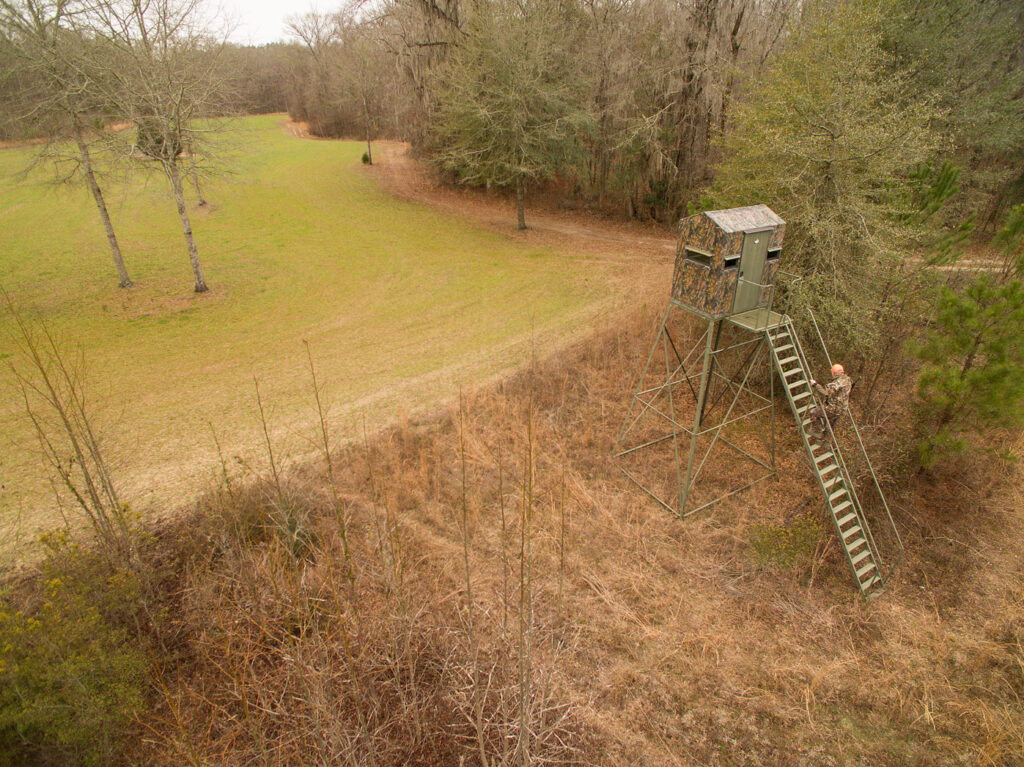
Many hunters choose to build their own stands. This gives them the freedom to customize the blind’s size, shape, and window configuration. The design of a shooting house is almost as subjective as to where to build it. Window height and size are important decisions that make the blind user-friendly, efficient and effective.
Other hunters choose to purchase a manufactured stand. There are many companies that offer fabricated shooting houses today. They vary in price and design but generally speaking if you can think of it, it is probably available.
The two companies who come immediately to mind are Red Neck Blinds and Ranch King Blinds. These companies offer first-rate shooting houses that give the hunter numerous advantages. Different window arrangements accommodate gun and bow hunters alike. Platforms and ladders vary in size and height allowing you to choose a stand that fits your needs and specifications.
These blinds are usually constructed of fiberglass and modern composite materials ensuring years of use. They also come with carpeted floors, composite shelves, sliding windows, lockable doors, and more. Perhaps the most important feature of manufactured blinds is the fact that they are almost air-tight. This means you can hunt them on almost any wind if you manage your scent by keeping windows and doors closed.
In Closing
Shooting houses, or permanent stands, are all about location, location, location! Once you have located that perfect spot it is only logical to place a stand that will be comfortable, effective, and efficient. After all, this where you will spend many hours in hopes of tagging your dream buck.
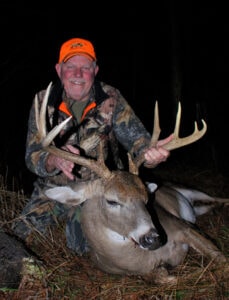 As with any stand for whitetails, hunting it with the wrong wind or getting busted repeatedly getting in and out can greatly decrease how effective you will be. Take all measures to hunt your stand undetected by deer. This will obviously increase your odds of tagging a buck greatly.
As with any stand for whitetails, hunting it with the wrong wind or getting busted repeatedly getting in and out can greatly decrease how effective you will be. Take all measures to hunt your stand undetected by deer. This will obviously increase your odds of tagging a buck greatly.
A shooting house is a great place to introduce kids or first-time hunters to the sport. Inexperienced hunters often have a short attention span. Boredom quickly sets in if the deer movement is slow. The confines of a good shooting house will allow for some movement and conversation that might calm nerves, call the shot, make the time pass quickly, answer the youngster’s numerous questions and keep the novice hunter in the field.
There is only one absolute rule to deer hunting success, “you must be present to win!” A comfortable shooting house will extend the time you or a novice hunter will spend on the stand, greatly increasing the odds for success.
Take the time and make the effort to find places on your property for permanent stands. Drill down on the why, when, and where of deer movement in a given area. Use optics to watch the area from afar and incorporate trail cameras and the evidence gathered from them to help you make the final decision on where your stands should be.
If you make the effort and use common sense in hunting your permanent stand I think you will soon discover you have found your own “Happy Place!”

